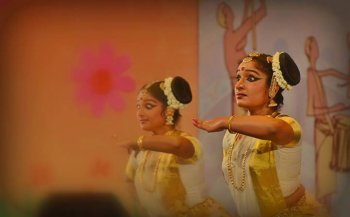
|   |

|   |
Dr. Neena Prasad’s students add sheen to Onam festivities - Supriya Rajan e-mail: supriya.dancer@gmail.com Photos: Gireesh Kumar September 25, 2013 It was going to be just another stay in Thiruvananthapuram, a city that I have started liking a lot but the Onam festivities made it a very special one. The city was brimming with the mood for celebration and as I entered Kanakakunnu Palace grounds to watch the evening’s Mohiniattam concert with my photographer friend who came all the way from Madurai just to soak in the festive spirit of his native city, we were drawn into a sea of crowd. Three elephants bedecked with traditional embellishments welcomed the crowd at the entrance accompanied by energetic musical percussion recital by a group of young boys. Amidst the crowd and the frenzy, we reached Nishagandhi open air theatre that has been witnessing many cultural shows over the past few days. We were there to watch the Mohiniattam concert by the disciples of Dr. Neena Prasad as part of Kerala Tourism Board’s Onam celebrations. The open air theatre was almost packed and though the crowd already had a treat of a high intensity Bharatanatyam concert, there was no sense of restlessness. It seemed the clouds too, shining under a near full moon, decided not to let the rain fall from its bosom unlike the early half of the day. It is not very often you get to watch group performances by students of eminent artistes on such prestigious stages like Nishagandhi. While Guru Neena Prasad took her seat among the musicians holding the cymbals, she looked proud as well as anxious. Her students positioned themselves on stage for the first piece of the evening, Cholkettu in ragam Atana and Chembada taalam, composed by Changanasseri Madhavan Namboodiri. As always the sight of the dancers in their gold and white costume and golden embellishments was splendid. The music flowed and they moved and swayed dancing with skill and perfection. The chollus had a regional touch which added to the celebrative mood of the Malayalis. Though strictly adhering to Carnatic music system, the composer could bring in the Kerala flavor that seemed to effortlessly blend with it. The thorough training that the guru imparts to her disciples was evident in their grasp of the technique and its execution. Over the years, with her detailed research and training, Dr. Neena Prasad seems to have crystallized a clear structure which gives a strong foundation to build on.  Ritu Binoy & Vidya Mol  Viswaroopam The main piece of the evening was a rare Stava Varnam by Maharaja Swati Thirunal set to music by Madhavan Namboodiri. Deviating from shringara bhava usually depicted in Mohiniattam recitals, this varnam spoke of the virtues of Sri Rama and didn’t have any gender identity for the narrator or dancer and it was directly portrayed purely through bhakti bhava. The three senior disciples Vidya Mol Pradeep, Ritu Binoy and Aswathi Krishna, who presented the varnam entered the stage carrying the essence of Rama in their gait and composure and soon exposed their skill and command over the dance form as they unveiled the intricate choreography. The pallavi, “Rama ava akhila ripuvaraama” which says that Rama is the destroyer of all evils within or outside, was portrayed through an episode where Arjuna (Vidya Mol), seeing the bridge to Lanka, wonders aloud on why Rama had to resort to the help of Hanuman and his army when he himself could have effortlessly built one with his proficiency in archery. Hanuman (Ritu) hearing it, sarcastically invites him to try building one with his arrows. Arjuna quickly builds a short one. Hanuman tries to jump on it and the bridge gives way. Arjuna feels humiliated and finds his existence as an ace archer worthless and tries to jump into the sacrificial pyre. Suddenly, a Brahmin (Aswathy) appears and urges Arjuna to have another go. Arjuna aims his arrows with a new vigour and as soon as it is built, Hanuman tries to jump on it yet again. But this time the bridge holds strong and Hanuman bent on proving his superiority assumes his giant form. Immediately he realizes that the Brahmin was none other than Sri Rama himself and both Arjuna and Hanuman realising their mistake shamefully bow in front of him. Rama thus destroys the wee bit of pride residing in their hearts. Vidya Mol got to the skin of the character while Ritu was sincere in her portrayal. In the pallavi “Kama manjima haari,” the dancers eloquently narrated how Manmadha who was proud of his own charms felt pale in front of the magnificence of Sri Rama. Through a short depiction of the story of Ahalya, they interpreted the charanam “Papa Gauthama Yosha.” Vidya Mol and Ritu presented the popular padam “Kanakamayamayeedum” from Swati Thirunal’s ‘Utsava Prabhandam’ which was followed by Dhanasree thillana by the group which by nature of it made the evening reverberate with the collective sensuality of ringing anklets. The last piece was a unique Dasavathara slokam from the text ‘14 Vritham’ by Kunjan Nambiar. Ten dancers effectively portrayed the avatars of Vishnu ending with Viswaroopam. After the mangalam was performed, the dancers formed an intricate pattern depicting the Anantha Padmanabha temple that received great appreciation from the audience.  Musicians It was a great treat for the people of Thiruvananthapuram as they celebrated Onam. The musicians of the evening, Changanasseri Madhavan Namboodiri - vocal, Vyppin Satheesh - mridangam, Kadanad VK Haridas - violin, Murali Krishna - veena, and Thrissur Krishnakumar - edakka, filled the air with soulful music and helped the dancers delight the audience. Their guru looked every bit a happy one. |